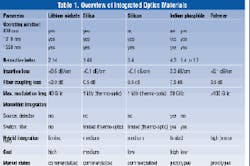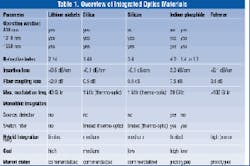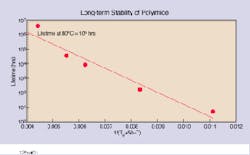Polyimide provides stable, low-cost integrated optics
Polyimide provides stable, low-cost integrated optics
Polymer materials for component substrates promise to clear the way for less expensive integrated optics.
CHRIS PFISTNER and GEORGE BALLOG, Lightwave Microsystems Corp.
Bandwidth demand in today`s telecommunications networks is increasing at a frantic pace, driven by applications such as the World Wide Web, graphics-intensive multimedia, and ever-increasing numbers of cable-TV channels. Optical technologies such as wavelength-division multiplexing (wdm), optical amplifiers, and high-bandwidth modulators are keys to unleashing the tremendous bandwidth potential of deployed fiber networks. But current optical component technologies require extensive manual assembly and are therefore expensive. As in the early days of the electronics industry, we now have a growing field of integrated optics where several components, including lasers and detectors, are integrated into one chip using special materials and semiconductor-like production processes.
Integrated optics overview
The use of guided optical paths on planar substrates to process different functions on one chip was first introduced by S. E. Miller at Bell Labs in 1969.1 Today there are several integrated optics technologies in different stages of development, ranging from research prototypes to field-proven devices (see Table 1). Each of these material systems has advantages and disadvantages:
Lithium niobate--Extensive research has been conducted on lithium niobate (LiNbO3) for applications in high-speed electro-optic modulators and optical space switches.2 Lithium niobate modulators capable of 2.5- and 10-Gbit/sec data rates have been commercialized over the past 15 years and are deployed in the backbones of optical transmission networks worldwide.
But lithium niobate is difficult to process and therefore costly. Furthermore, its crystalline structure prohibits monolithic integration of laser sources and detectors. The mismatch between the velocity of the light traveling in the lithium niobate waveguide and the microwave used to modulate the device limits the upper modulation frequency to about 40 GHz. Moreover, as a crystalline material, lithium niobate shows high birefringence that leads to high polarization-dependent losses. Another drawback is that lithium niobate has a considerable refractive-index mismatch with silica fiber, which leads to high coupling losses of about 1.5 dB per fiber attachment point.
Silica-on-silicon and silicon-on-silicon--These material systems have been the focus of substantial research and development, and passive devices made of these materials, such as splitters and filters, are commercially available today. The silica system has the advantage that its index of refraction is perfectly matched to silica fiber. But the only active devices demonstrated to date have been thermo-optic switches with modulation frequencies that are inherently limited to the millisecond range. The silicon system also has the advantage of using the manufacturing process that has been optimized in the semiconductor industry during the past 30 years. On the other hand, because of its high absorption in the 830-nm window, silicon is limited to applications in the 1310- and 1550-nm transmission windows.
Indium phosphide--Research efforts are currently under way on integrated optical devices based on indium phosphide (InP). Monolithically integrated devices with lasers and detectors grown on the same chip have been demonstrated. Current limiting factors include high production costs and considerable insertion loss at the fiber interfaces due to index mismatch. Indium phosphide is not expected to be commercially available before the end of the decade.
Polymers--Research and development of polymers for optical applications began more than 15 years ago. Polymers offer a wide range of refractive indexes closely matched to that of silica fiber, and therefore it is possible to optimize the material sets for different applications in all three transmission windows of silica fiber. Polymers are also inherently inexpensive to produce and process. The most notable drawback so far has been the limited environmental stability of most polymer materials.
Evolution of polymer devices
Extensive research has been done in the field of polymer-based integrated optical components over the past 15 years.3 One of the early motivations for developing electro-optic polymer-based materials was their use in high-data-rate external intensity modulators. For this purpose, an electro-optically active compound called a chromophore is incorporated into the polymer molecule. Because polymers provide a better match between the velocity of the light traveling in the waveguide and the microwave than does lithium niobate, they exhibit considerably higher modulation frequencies. The reported record in modulation frequency is an impressive 113 GHz.
The rapid acceptance of wdm has led to demonstrations of wavelength filters in polymers. Prototypes of arrayed waveguide gratings have been demonstrated in polymers for the 1550-nm erbium-doped fiber amplifier passband using the International Telecommunication Union channel grid.4
The deployment of wdm systems is only the first phase in the evolution of the optical network. To take full advantage of the increased traffic capacity in the point-to-point links, optical switching needs to be implemented in the crossconnect sites. Integrated 8 ¥ 8 optical switch arrays in single-substrate polymers have been demonstrated.5 The first-generation switches are based on a thermally induced change of the refractive index that results in slow switching times--on the order of milliseconds. This is sufficient for circuit switching, but more-advanced optical packet switching will require switching times on the order of nanoseconds. Electro-optically active polymers like those used in high-bandwidth modulators are a promising solution.
Overview of optical polymer materials
Polymer materials used in optical communications need to meet two primary criteria: low and stable optical insertion loss (typical value: 0.1 dB/cm); and thermal and mechanical stability. Thermal stability in polymers is usually characterized by the decomposition temperature, Td, and the glass transition temperature, Tg. Td is the temperature above which the molecular bonds of the material start to decompose. Tg is the temperature at which the mechanical strength of the material decreases abruptly. The following section gives an overview of polymer materials used in optical applications (see Table 2):
Polycarbonate--Polycarbonate is a polymer material with low decomposition and glass transition temperatures in the range of 200C and about 150C, respectively. This thermal stability is too low for applications in communications, but polycarbonate`s relatively high refractive index makes it the polymer of choice for a wide range of lenses (e.g., safety eyeglasses).
Polyurethane--Polyurethane can be easily processed and can incorporate electro-optically active material for modulators and switches. As a result, polyurethane is frequently used in research and development projects. However, like polycarbonate, its thermal stability is too low to allow its use in commercial applications in communications.
Acrylate--Acrylate shows decomposition and glass transition temperatures similar to polycarbonate and poly- urethane. Acrylate has favorable properties such as low birefringence and attenuation and can be processed in very thick layers (>100 micron). It is widely used in research and development, and is one of the materials of choice in high-quality PC boards and plastic fiber. (Polymethylmethacrylate--pmma--is one of the better-known acrylates for such applications.) No electro-optically active devices made of acrylate have been reported to date.
Polyimide--Polyimide is a polymer material with high decomposition and glass transition temperatures of more than 400 and 340C, respectively. It also demonstrates excellent mechanical stability and allows the incorporation of chromophores for high-speed modulators and switching devices. With special processing, polyimide shows low optical insertion loss in all three transmission windows of optical fiber. Because of its attractive optical properties and high stability, polyimide is a prime candidate for a wide range of passive and active optical components.
Polyimide: stability and performance
The initial development of polyimide by DuPont started in the mid-1950s. By 1965, DuPont had three polyimide products: Kapton for thin film, Vespel for molding, and Pyre-ML for wire insulation. Among polymer materials, polyimides have several unique properties:
Thermal stability--Polyimide does not suffer thermal breakdown until above 400C, whereas most other polymers decompose in the range of 100 to 200C. Polyimide easily withstands soldering processes and is therefore used in high-quality PC boards.
Mechanical stability--Polyimide is used as cover coating in integrated circuits, in special-purpose PC boards, and even in aerospace applications as a high-performance composite material in lightweight structures.
Electrical/optical stability--Polyimide is a class H insulator with a dielectric breakdown point of 350 V/mm. Stability under exposure to high-intensity light sources is similarly high.
ntt and Hitachi pioneered the development of low-loss polyimides for passive devices in optical communications. Lightwave Microsystems and its predecessor, roi Tech, pioneered the development of highly stable chromophores compatible with the passive polyimide material system.6,7 Decomposition and glass transition temperatures for the active materials are about 340 and 280C, respectively. The figure shows the extrapolated long-term stability of the active material in a standard Arrhenius plot. At 80C the useful lifetime of the active material is about 106 hours--well over 100 years.
Polyimide in optical communications
With its attractive combination of optical, thermal, and mechanical properties, polyimide is well-suited to a wide range of integrated planar waveguide circuits. These devices can be divided into three groups:
Passive single function devices--power splitters, wdm filters--Singlemode optical power splitters are traditionally implemented by fusion splicing singlemode fibers. This approach is cost-effective up to about a 1 ¥ 8 split. Beyond this point planar circuits become attractive. Polyimide-based splitters promise the same performance at reduced costs. A new generation of dense wavelength-division multiplexing (dwdm) filters based on planar circuits is entering the market in response to the demand for lower cost. The first devices are based on silica, but polyimide devices again have the inherent advantages of low cost and high environmental stability. Commercial polyimide devices are expected to enter the market in 1998.
Active single-function devices--optical switches, modulators, and attenuators--As the need for fast optical switching evolves, inherently fast electro-optical switches will be needed. Polyimide-based electro-optic switches have already demonstrated switching speeds below 1 nsec. High-data-rate digital and analog modulators and tunable attenuators can also be implemented with polyimide.
Integrated devices--N ¥ N switch matrices, optical add/drop multiplexers, integrated transceivers--As optical crossconnects enter the field-trial phase, large-scale switch matrixes are needed. Planar technologies have an inherent advantage over discrete components in terms of ease of manufacturing, reliability, and low cost. The rapidly increasing deployment of wdm systems creates the need to add and drop individual channels at intermediate amplifier sites. Current solutions offer passive add/drop multiplexers. Polyimide allows the integration of dwdm filter functions and space switches on a single substrate, thus enabling reconfigurable optical add/drop multiplexers.
Integrated planar circuits are a good solution to the need for transceiver chips with laser sources and detectors directly integrated into the circuit. Edge-emitting lasers can be coupled directly into wave-guides, or vertical-cavity surface-emitting lasers can be coupled into waveguides through mirror vias. Applications range from low-cost integrated lan transceivers to integrated low-cost wideband transceiver chips for fiber-to-the-curb and fiber-to-the-home. Since low cost is key in all these applications, polyimide is especially attractive as a material platform.
Conclusions
With its unique combination of optical properties and environmental stability, polyimide is a promising material platform for a wide range of low-cost integrated optics. Such optics will form the base for cost-effective optical networks with the necessary bandwidth to support tomorrow`s telecommunications infrastructure. u
References
1. S. E. Miller, "Integrated Optics: An Introduction," Bell Sys. Tech. J., vol. 48, no. 7, 1969, pp. 2049-69.
2. E. J. Murphy, "Applications of Integrated Optic Switches in wdm Networks," Digest of leos Summer Topical Meetings, Montreal, Canada (Aug. 11-15, 1997) paper ThA1, p. 27.
3. L. A. Hornak et al., Polymers for Lightwave and Integrated Optics: Technology and Applications, New York: Marcel Decker, 1992.
4. M. B. J. Diemeer et al., "2.6 Terabit/s wdm Transmission Experiment Using Optical Duobinary Coding," Proc. 22nd Euro. Conf. Opt. Commun., Oslo, Norway (Sept. 15-19, 1996), post-deadline papers, vol. 5, pp. 3-6.
5. A. Borreman et al., "Polymeric 8 ¥ 8 Digital Optical Switch Matrix," Proc. 22nd Euro. Conf. Opt. Commun., Oslo, Norway (Sept. 15-19, 1996), post-deadline papers, vol. 5, pp. 59-62.
6. J. T. Kenney et al., "nlo Polymer Material Systems for Electro-Optic Devices," Electrical, Optical, and Magnetic Properties of Organic State Materials, Material Research Society Proceedings (Jan. 1996), pp. 1-6.
7. J. C. Chon et al., "High Thermal Stability Electro-Optic Polymer 1 ¥ 4 Optical Switch," Proc. spie Conf. Critical Reviews of Optical Science and Technology, Optoelectronic Interconnects and Packaging, San Jose, CA (Jan. 31, 1996), pp. 1-9.
Chris Pfistner is director of product marketing and George Ballog is vice president of marketing and sales at Lightwave Microsystems Corp., Santa Clara, CA.Standard Arrhenius plot shows the long-term stability of electro-optic activity in polyimide. Tg is the glass transition temperature, +50 is an empirical offset, and T is the temperature parameter. The useful lifetime is defined as the period within which the electro-optic reactivity drops by 20%.


